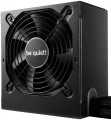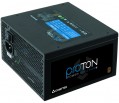Efficiency
Efficiency, in this case — the ratio of the power of the power supply (see "Power") to its power consumption. The higher the efficiency, the more efficient the power supply, the less energy it consumes from the network at the same output power, and the cheaper it is to operate. Efficiency may differ depending on the load; the characteristics can indicate both the minimum efficiency and its value at an average load (50%).
It should be noted that compliance with one or another level of 80PLUS efficiency directly depends on this indicator (for more details, see "Certificate").
ATX12V version
A standard for power supplies that supplements the ATX specifications regarding power supply along the 12 V line. Introduced into use since the time of the Intel Pentium 4 processor. In the first series of the standard, the +5 V line was mainly used; from version 2.0, the +12 V line was introduced to fully power the components computer. Also in the second generation, a 24-pin power connector appeared, used in most modern motherboards.
Braided wires
The presence of a braid in the complete wires of the system unit — for all or at least for some.
This feature has a positive effect on reliability, making the wire as resistant as possible to bending, abrasion, strong pressure and other similar influences; it also provides additional protection against accidental contact with sharp objects (for example, when repairing a PC). The disadvantages of braided wires, in addition to increased cost, are also increased thickness and greater rigidity than similar cables in conventional insulation. This can create some difficulties in organizing space inside the system unit.
+3.3V
The maximum values of current and power that the PSU can provide on individual power lines.
The power line can be simply described as a pair of contacts for connecting a particular load; one of these contacts is “ground” (with zero voltage), and the second has a certain voltage with a plus or minus sign, this voltage corresponds to the voltage of the power line. In this paragraph, it is + 3.3V (such power is present in 20- and 24-pin connectors for motherboards, in SATA power connectors and some other types of connectors).
In general, power and currents are rather specific parameters that the average user rarely needs — mainly when connecting high-power components such as video cards, as well as when starting a PSU without a computer to power other electronics (for example, amateur radio stations). It is also worth mentioning that the sum of the maximum powers on all lines can be higher than the total output power of the PSU — this means that all lines cannot operate at full power at the same time. Accordingly, when the PSU is fully loaded, some of them will produce less power than the maximum possible.
+5V
The maximum current that the PSU is capable of issuing + 5V to the power line. For more information about power lines in general, see "+3.3V". Also note here that + 5V power, in addition to connectors for motherboards (for 20 and 24 pins), is also found in Molex and SATA plugs, as well as some other specific types of connectors.
+12V1
The maximum current that the PSU is capable of delivering to the first power line is + 12V.
For more information about power lines in general, see "+3.3V". Here it is worth mentioning that 12 V is the most popular voltage among computer power connectors. It is used in almost all such connectors (with a few exceptions), and some plugs (for example, additional PCI-E power for 6 or 8 connectors) use only 12-volt lines — and in the + 12V format. And the division of + 12V power into several separate lines is used for safety purposes — in order to reduce the current flowing through each individual wire, and thus prevent excessive load and overheating of the wiring. However, some manufacturers do not specify the maximum current for individual + 12V lines and give only a general value in the characteristics; in such cases, this number is indicated in this paragraph.
+12V2
The maximum current that the PSU is capable of delivering to the second power line is + 12V.
For more information about power lines in general, see "+3.3V". Here it is worth mentioning that 12 V is the most popular voltage among computer power connectors. It is used in almost all such connectors (with a few exceptions), and some plugs (for example, additional PCI-E power for 6 or 8 connectors) use only 12-volt lines — and in the + 12V format. And the division of + 12V power into several separate lines is used for safety purposes — in order to reduce the current flowing through each individual wire, and thus prevent excessive load and overheating of the wiring. However, some manufacturers do not specify the maximum current for individual + 12V lines and give only a general value in the characteristics; in such cases, this number is indicated in the paragraph "+12V1".
+5Vsb
The maximum current that the PSU is capable of issuing + 5Vsb to the power line.
For more information about power lines in general, see "+3.3V". Specifically, the + 5Vsb line is used to power the computer electronics in standby mode, when the main and only task of the system is to respond to pressing the power button. This does not require high power, so this figure rarely exceeds 3A.
+12V
The maximum power that the PSU is capable of delivering to the + 12V power line.
See "Maximum current and power" for details on power lines in general. Here it is worth mentioning that 12 V is the most popular voltage among computer power connectors. It is used in almost all such connectors (with a few exceptions), and some plugs (for example, additional PCI-E power for 6 or 8 connectors) use only 12-volt lines — and in the + 12V format. So this indicator is one of the most important characteristics of any PSU.
Note that many power supplies have several separate + 12V power lines. In such cases, the total power is indicated here, which, usually, is divided equally between the lines.

